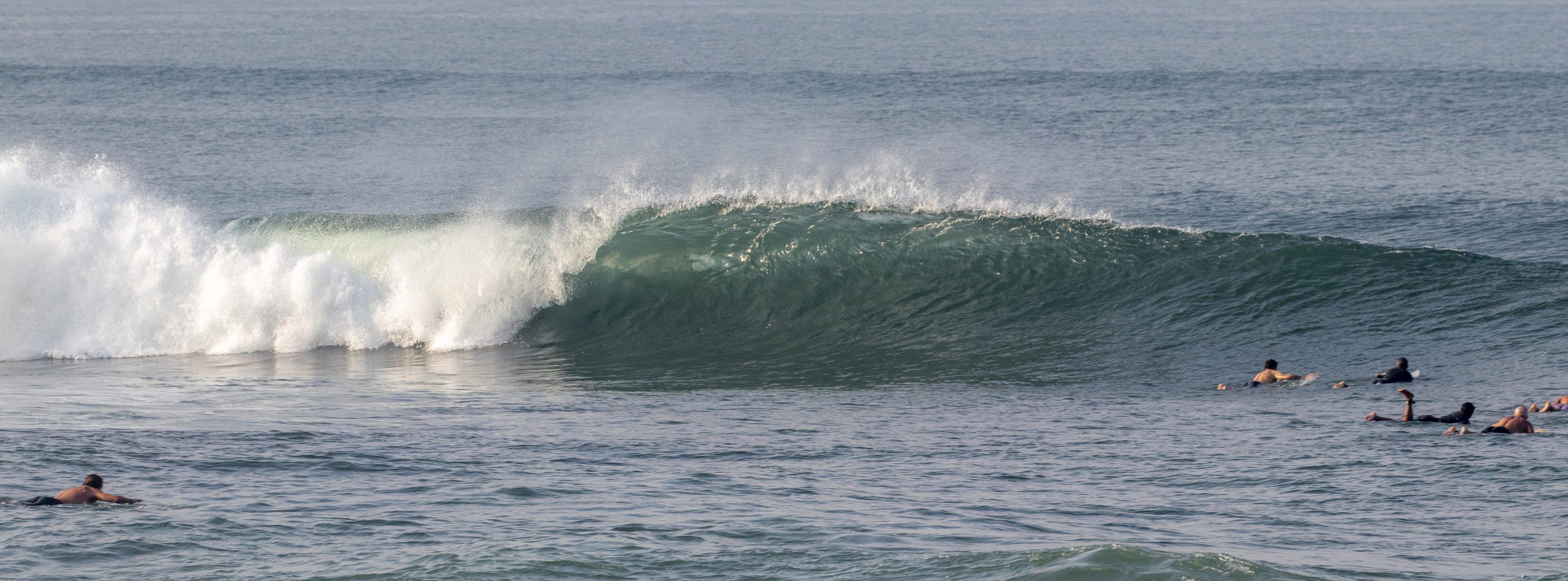
The Complete Guide to Surfing Canggu
Canggu is a thriving area of Bali with a vibrant surfing community having now replaced Kuta/Seminyak as the most popular holiday/party destination. While there are various high performance and mellow waves in the Canggu area, it does not compare with the Uluwatu area for variety of surf breaks, and can not hold a big swell like the reefs on the Bukit.
Canggu is best for surfing when it is head high, with set waves up to head and a half high. Any smaller, and the waves are very inconsistent. Any bigger, and it becomes very challenging.
This collection of small villages located on the west coast of Bali is home to many great surf spots that are divided into 5 beaches:
Some of these beaches contain several surf spots (such as Echo Beach) that cater to a wide array of surfing abilities and are open to swells from all directions.
Canggu surf spot information
Echo Beach
Echo Beach is one of the main surf spots in Canggu. It’s a beautiful beach with black sand and stunning views.
This is home to Echo Beach Left, The Sandbar, and River Mouth.
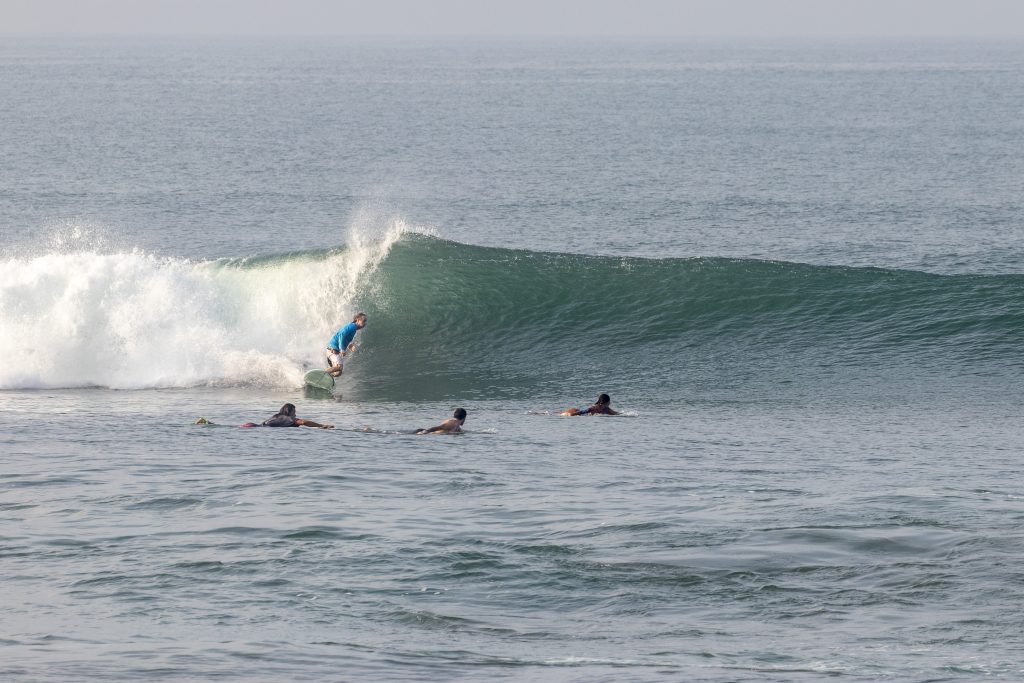
Stairs
Stairs is named such as there are stairs leading down to the beach from the nearby cafes and parking area. Stairs is also known as Echo Beach Left. It is a powerful left-hand wave that breaks over a shallow reef. It’s known for barrelling sections and is suitable for experienced surfers.
Stairs breaks directly in front of some great cafes, so your friends can be sipping cappuccinos while watching you doing floaters and aerials just 50 meters away.
The wave quality tends not to be as good at low tide when the reef is exposed. Stairs is best surfed at mid to high tide.
The wave tends not to barrel at high tide as the water is too deep. But instead provides a solid performance wall for big turns and lip smacks. You’ll often find a crowd here consisting of surfers from intermediate to expert.
The Sandbar
The Sandbar is positioned between Stairs and River Mouth.
This is an A-Frame wave that breaks both left and right. It’s an advanced-level wave with a shifting peak.
The left-hand breaking wave barrels on the take-off with enough swell. It offers steep, high-performance walls for surfers to carve maneuvers and push their limits.
The right-hand breaking wave does look appealing. But it’s a short and less steep ride that fizzles into the channel near to Stairs.
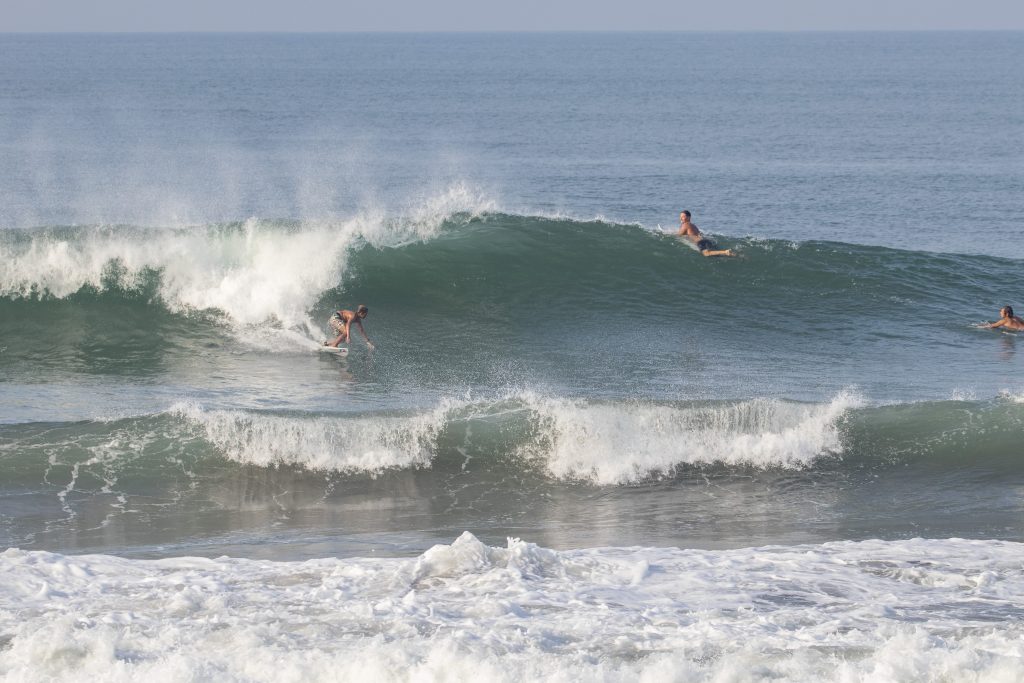
Like most breaks in Canggu, The Sandbar needs a mid to high tide to break best.
You’ll often see experienced surfers practising aerial manoeuvres here as the wedgy peaks and sandy bottom create ramps that allow surfers to launch into the air. Some surfers arrive late morning after the crowds are lighter as a light onshore wind is more conducive to pulling airs.
The Sandbar is the only beach break at Canggu with a sandy bottom.
River Mouth
Canggu’s River Mouth is regarded as the standout surf spot in the area. It offers a hollow right-hand wave that breaks with barreling sections.
The wave typically breaks best during high tide when the water fills in over the volcanic rock shelf.
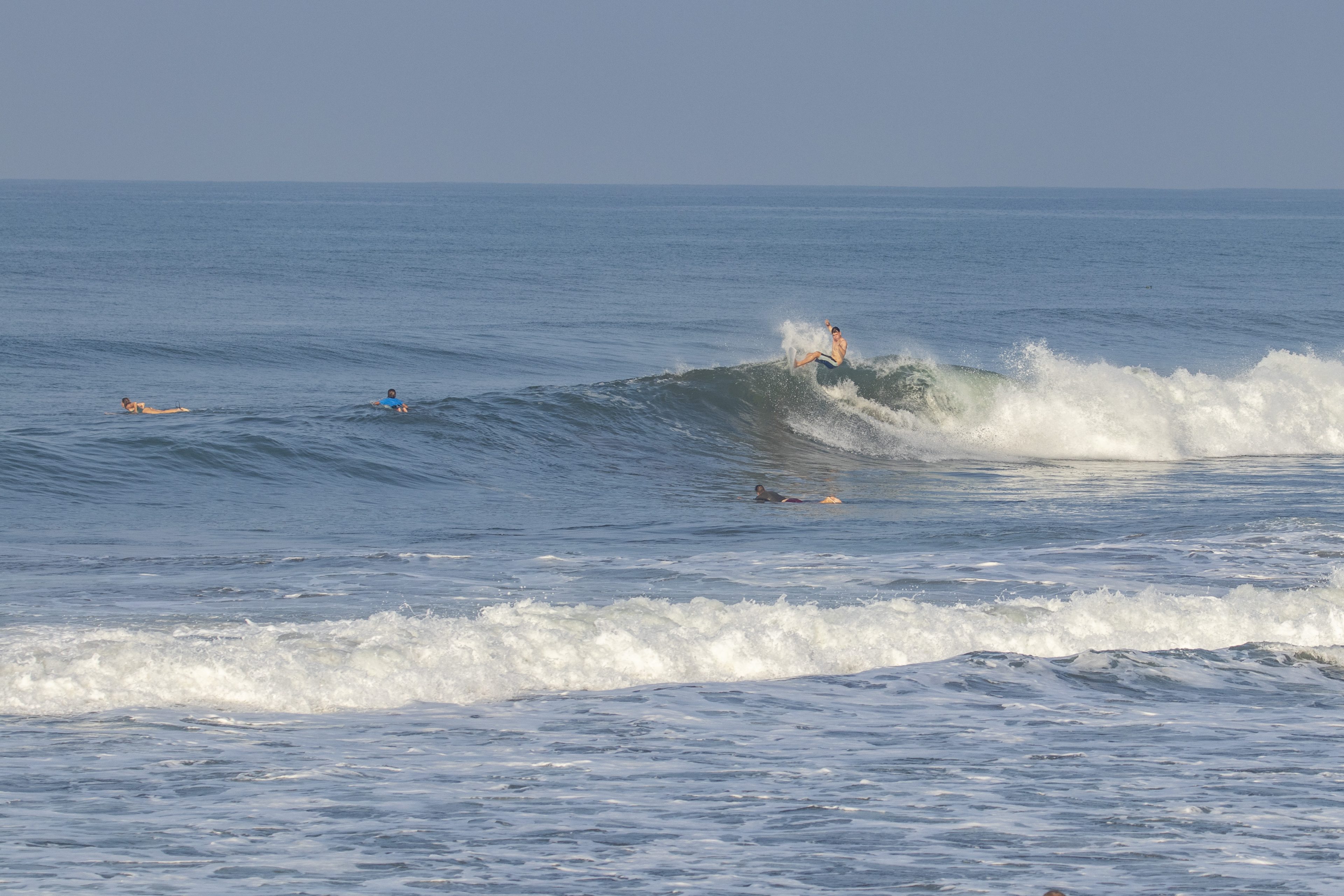
At low tide, the water becomes too shallow and the wave breaks too fast to ride. It is shallow and dangerous at low tide.
River Mouth can hold a wave size of up to about 1.5x overhead. But if the swell size is much bigger than this, then the wave tends to close out.
This renowned spot often attracts top local surfers and visiting pros. For example, Rob Machado made it his home here for a few years.
You can also find a left-hand wave breaking off the peak. If the conditions are good, this can produce a fun wave.
Batu Bolong Beach
Batu Bolong Beach sits at the far end near the busiest part of Canggu.
It’s located just south of Echo Beach and is named after the limestone cave that pierces through the cliff behind the beach.
Batu Bolong Beach is home to two beginner-friendly breaks, Batu Bolong and Old Man’s.
Batu Bolong
Batu Bolong is a wave that breaks left and right and can peel for more than 100 meters.
Batu Bolong offers softer waves and is a popular choice among beginners and longboarders.
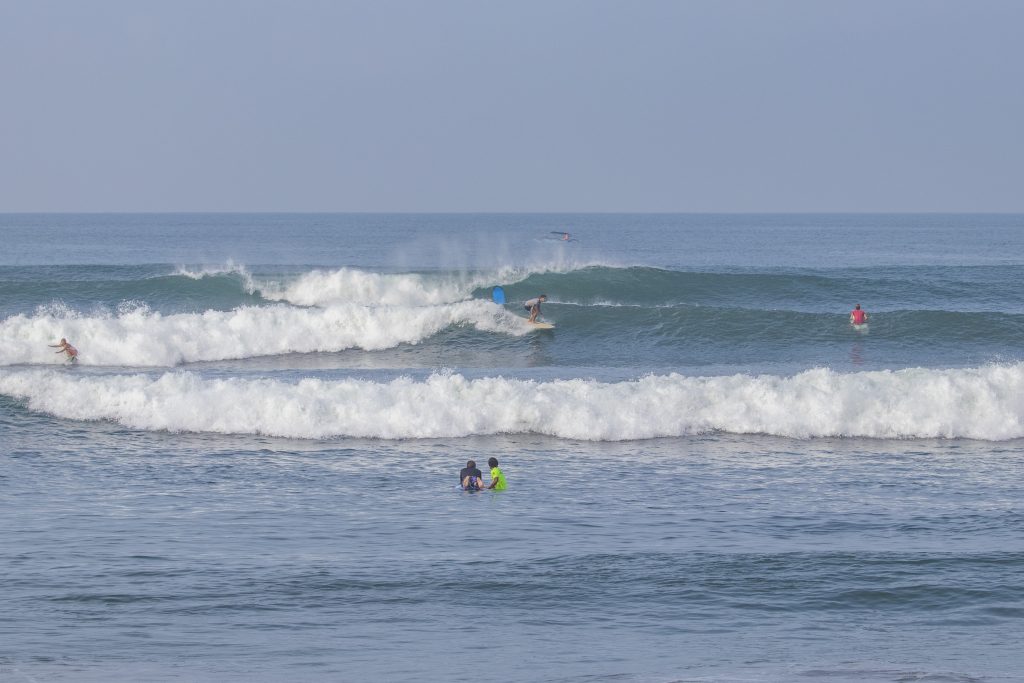
Given its location and soft-breaking characteristic due to flat bathymetry, Batu Bolong tends to draw large crowds and is one of Bali’s best beginner-intermediate waves. Loggers love it, particularly the ladies.
So if you plan to surf Batu Bolong, then we advise you to get an early start in the morning when the conditions are optimal and the crowd is manageable.
Due to the soft-breaking nature of the wave, it’s not unusual to see two or three surfers riding the same wave. Sharing is caring.
Old Man’s
Old Man’s sits on the other side of the channel from Batu Bolong.
This is another spot in Canggu that’s ideal for beginners because it offers a mellow wave. The wave peaks and provides both left and right-hand breaking options.

When the swell is small and during high tide, the wave can become even softer and fade into the channel. So surfing Old Man’s at low to mid-tide is recommended when the swell is smaller.
As the swell increases in size, the right-hand waves at Old Man’s tend to close out. But the left maintains its quality.
Old Man’s isn’t the most consistent wave in Bali, so it’s typically avoided by experienced surfers.
But Old Man’s remains a favored spot by novice surfers and old men, and offers opportunities to practice their skills.
Berawa Beach
Berawa Beach provides an array of thrilling surfing opportunities, including a high-quality beach break and two exceptional reef breaks, all right in front of the upscale Finns Beach Club.
Intermediate surfers tend to flock to Berawa as the wave is steep enough to ride smaller boards yet breaks at a much slower speed than the advanced waves in Canggu.

These spots are usually less crowded compared to the other spots in Canggu.
The beach break is called The Peak, and the reef breaks are The Ledge and The Bombie.
The Bombie should not be confused with the similarly named peak in Uluwatu (any wave that breaks soft and further out is an indicator wave and is commonly referred to as a bombie).
The Peak
The Peak offers a dynamic wave that can run for up to about 80 meters.
On bigger days, you can expect high-performance walls and the occasional barrel.
While on smaller days, you can expect more approachable and mellow peeling waves. The Peak is suitable for beginner surfers on smaller days.
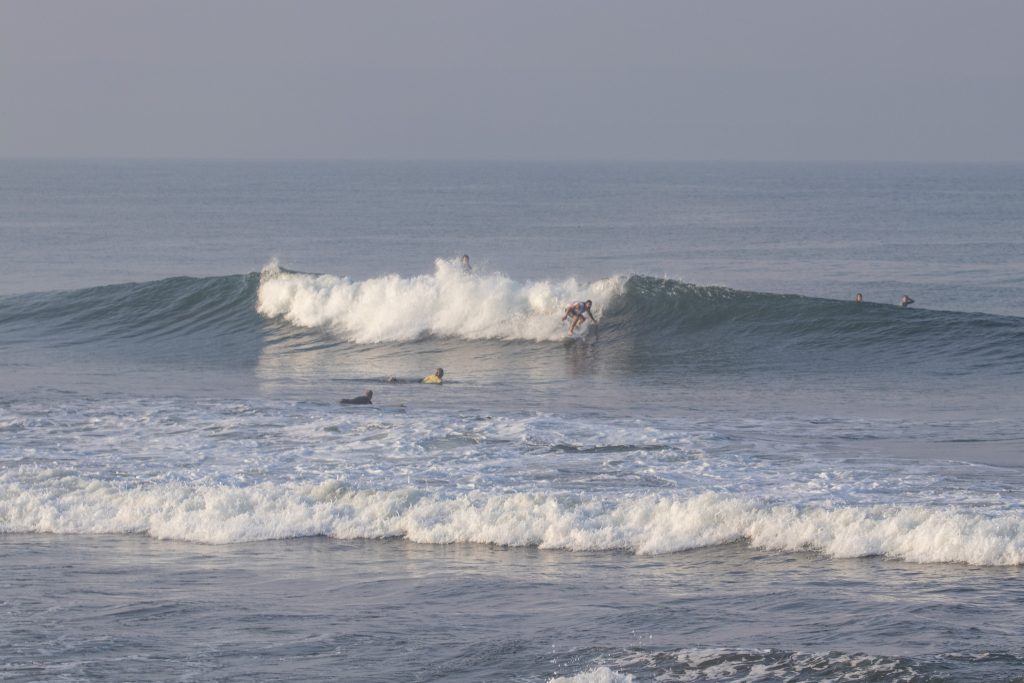
The Peak is versatile and breaks on a mid to high tide and works in all conditions. So there’s something here for all surfers who can handle a quality wave.
The Ledge
The Ledge is a reef break that comes to life on a low tide and a powerful swell. In these conditions, you’ll see fast and barreling right-hand breaking waves.
It’s important to note that this wave is shallower than it appears, so it’s possible for surfers to hit the bottom. All waves break in a depth of water that is proportional to the size of the wave. The shallowness or deepness of the water is variable after the wave breaks, depending on if the bottom is flat or steep. The ledge has a steep bathymetry hence it’s name and risk of hitting the bottom.
If the waves are under head-high, The Ledge is too fast to make the section, making this spot for advanced surfers only.
The Bombie
The Bombie is a right-hand breaking wave that breaks further out to sea and towards Nelayan Beach.
Like The Ledge, The Bombie requires a powerful swell to produce rideable walls. If the waves are too small, the wave peaks up but does not break as the water is too deep.
At mid tide, you can get longer soft waves that break over the reef from a steep take-off. As the wave progresses to the shore, you can expect a more pronounced shore break.
The Bombie is a lesser-known spot in Canggu, so you can expect fewer surfers here compared to other surf spots. It is popular with SUP’s and surfers with bigger boards.
Pererenan Beach
Pererenan Beach is located just north of Echo Beach and is another black sand beach.
This is home to the surf spot Pererenan. Pererenan is a reef break with both left and right-hand breaking waves.

You need a mid to high tide to surf Pererenan as the wave breaks over a shallow rock shelf. The rights offer longer walls while the lefts offer a more intense ride, but you must remember to kick out quickly before it gets too shallow.
Pererenan is a popular choice among intermediate-level surfers due to its relatively low crowd levels compared to bustling spots like Echo Beach and Batu Bolong in Canggu.
Additionally, the waves at Pererenan offer a more relaxed pace, making it an ideal destination for surfers looking for a less competitive experience.
Nelayan Beach
Nelayan Beach can be found between Berawa Beach and Batu Bolong Beach.
You can expect Nelayan to be less crowded compared to the other beaches in Canggu. So it can be a peaceful retreat for beachgoers.

The surf at Nelayan is decent, but it can often get blown out by the wind.
When the wind picks up, this spot becomes a hub for kite surfing.
Can beginners surf Canggu?
Canggu has a wide range of surf spots catering to all abilities, including beginner surfers.
The best place for beginners to surf in Canggu is Batu Bolong Beach. This is home to Batu Bolong and Old Man’s with more gentle and forgiving waves, which are great for learning to surf.
The best time for beginners to surf in Canggu is early in the morning when the waves will be less crowded.
It can get very crowded in Canggu. The crowds can be challenging for beginner surfers.
The Peak at Berawa Beach is also suitable for beginner surfers on a small swell and can be less crowded than the breaks at Batu Bolong Beach.
Canggu is a great place for beginners to learn how to surf. Because Canggu is a vibrant surf area, you can find many surf camps and surf schools that cater to beginners, as well as shops to hire equipment.
Can intermediates surf Canggu?
Berawa and Batu Bolong are both suitable spots for intermediate surfers as the waves break slowly and softly. Nelayan is another option for intermediates if the swell is around shoulder-head high.
The breaks at Echo beach and Perenanan are performance waves, and it is usually crowded with advanced surfers so very difficult for intermediates to get a decent ride.
When is the best time to surf Canggu?
The best time to surf Canggu is in the dry season, which runs from April to October. The winds are typically light and offshore during the dry season, which helps to improve the wave quality.
During the dry season, Canggu receives consistent swells from the Indian Ocean. The conditions in the dry season are usually ideal for intermediate to advanced surfers because the swell is larger and more consistent than the wet season.
The mornings at Canggu are usually offshore due to the cool wind blowing from Bali’s mountainous interior. From around 10 am in the dry season, the trade winds will blow sideshore at Canggu and degrade the quality of the waves.
The wind tends to drop off for a sunset session. But the mornings at Canggu are almost always prime time for surfing.
The wet season, which runs from November to March, can still be good for surfing in Canggu. The winds are usually stronger and predominantly from the west or southwest, which is onshore and can worsen the wave quality.
But you can still get some light wind days during the wet season. We advise you to keep aware of the wind conditions during the wet season, as the wind can and does switch from onshore to offshore during the day, and there will be windows of time where the wind is very light. Variable conditions require you to be vigilent to get optimum surfing conditions.
All the beaches at Canggu face the same direction. So there is nowhere close by to avoid an unfavorable wind direction.
The surf is usually smaller and less powerful during the wet season but it’s nearly always at least sholder-head high.
The surf is almost always big enough, but the winds are not reliable and there will be many onshore days. The wet season is a good time for beginners looking for smaller and more forgiving waves to learn to surf, but best to avoid January as the winds can be very strong.
Throughout the year, you can expect a diverse range of surf conditions, which can offer great opportunities for surfers of all levels. Some days will see powerful waves, perfect for experienced surfers seeking a challenge, while other days will provide more gentle, beginner-friendly waves for those just starting out. It’s all part of the beauty of surfing and embracing the natural elements.
Canggu is a popular surfing destination year-round. So even in the so-called “off-season” you’ll still find surfers enjoying the waves and vibrancy that Canggu has to offer.
Where to stay in Canggu
The choice of accommodation is enormous and ever changing. There is very little beach front accommodation and the limited availability drives the price very high. Best to stay a little bit inland – almost everywhere in Canggu is within a 10 minute motorcycle ride to a surfing beach.
Where to eat in Canggu
The choice of dining options is incredible with new restaurants opening daily. La Brisa and the Lawn are great places for breakfast and lunch as they both have great sea views.
Where to do for non-surfers in Canggu
Canggu is the beach club metro of Bali with both Atlas Beach Club and Finns Beach Club very popular sunset spots with lively nightlife. There is an abundence of Yoga studios, gyms, spa studios and wellness places dotted all around Canggu. Canggu is very popular with digital nomads and there is a wide selection of very modern Co-working facilities where you can buy daily, weekly or monthly membership.
Conclusion
Until recently, Canggu was a collection of small fishing and farming villages.
Gradually, surfing has become more popular in Canggu. Basic accommodation was built to accommodate surfers who wanted to stay near excellent waves in an area much more tranquil than Kuta.
Canggu has replaced Kuta as the go-to holiday destination in Bali. During the pandemic Canggu became the main tourist hub, and it has remained so. Non-surfing tourists love the choice of restaurants and nightlife. This is the hipster capital of Asia, with vibrant nightlife and huge beach clubs catering to the masses.
Digital nomad surfers prefer Canggu to Uluwatu as it does not involve a hike up and down cliffs to access the beach. It is popular with expats as there are international schools, and a huge range of gyms and other facilities that you would find in a western country.
Canggu is a popular surfing destination with a wide array of great surf spots that offer something for every level of surfer. From powerful and barrelling waves to softer and more forgiving breaks, Canggu’s beaches cater to surfers of all skill levels from total beginner to expert.
Canggu has a diversity of surf spots including Echo Beach, where you can find the performance waves of Echo Beach Left, Sandbar and River Mouth is great for advanced surfers. Batu Bolong Beach can be perfect for beginners, intermediates and longboarders due to its soft breaking long and gentle waves.
So if you’re looking for a great place to surf and party or work, then you’ll definitely want to check out Canggu. With its quality waves, vibrant surfing community, and endless parties, Canggu is well worth a visit.